The Panzer II Ausf. C Tank
This German Panzer II tank PzKpfw II Ausf C Sd.Kfz. 121 can be found at the French Tank Museum in Saumur in the Loire Valley. The Museum is called Musée des Blindés ou Association des Amis du Musée des Blindés, 1043, route de Fontevraud, 49400 Saumur, France www.museedesblindes.fr . The word Blindés means armoured.
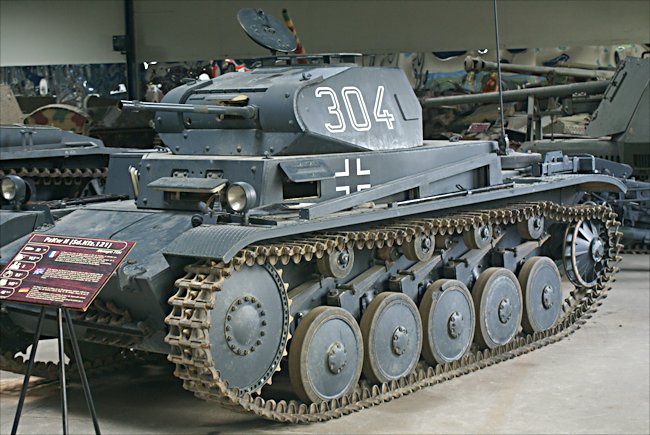
German Panzer II tank PzKpfw II Ausf C Sd.Kfz. 121
Saumur's Tank
This PzKpfw. II Ausf. C was rescued from a scrapyard from Trun, France in 1980. When the top coat of paint was removed during the restoration process it was discovered that it had the Divisional sign of the 2nd Panzer Division. This was probably it's original panzer unit. In 1944 it was transferred to the Sturm Panzer Abt 217 and was given a new tactical number "304". It was used as a command and observation vehicle. It has been restored with the correct paint for a Panzer II used during the invasion of France in May 1940 but it has the wrong tactical number on it from when it saw service in Normandy in 1944.
Panzer II and the log bridge
In early 1941 German tank crews like Lugwig Bauer were ordered east. There was a big build up of men and machines. On the 26th June 1941 Operation Barbarossa, the invasion of Russia was launched. Lugwig recalls, "We fought constantly, we were always in action. There were tank battles and infantry battles every day."
In the first few months of the attack the Germans had the upper hand through use of mobile armour and superior fire power. As they got nearer Moscow resistance grew stronger. Lugwig continued, "The Russians never gave up no matter how hopeless he situation was. I was sometimes incomprehensible to us, stubborn."
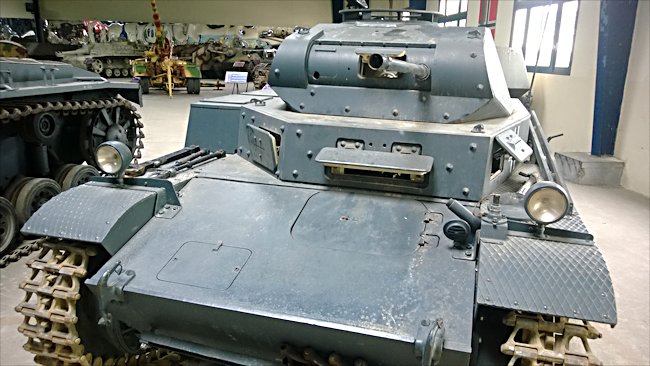
German PzKpfw II Ausf C Tank
Hitler ordered one last final push to take the industrial city of Tula and Moscow before winter. Some German Divisions had lost nearly 50% of their strength after 15 weeks of hard fighting. What the Germans did not realise was that the Russians had a plan. He would let them advance and lengthen their lines of supply and communication. They would fight a defensive delaying action and wait for the Winter to do its work. The Russians were used to the harsh freezing snowy conditions. The Germans did not even provide their troops with adequate clothing.
To protect their capital the Russians only had 700 light tanks, 100 T34/75 medium tanks and 47 KV-1 heavy tanks. The Germans attacked with around 1,000 Panzer Mark III and IV medium tanks and over 500 light tanks mainly antiquated Panzer II. Lugwig Bauer was a tank commander of the three man Panzer II. It was designed as a stop gap whilst other tanks were developed. It only had a 20mm gun and only 35mm of frontal armour. It was no match for the Russian medium and heavy tanks.
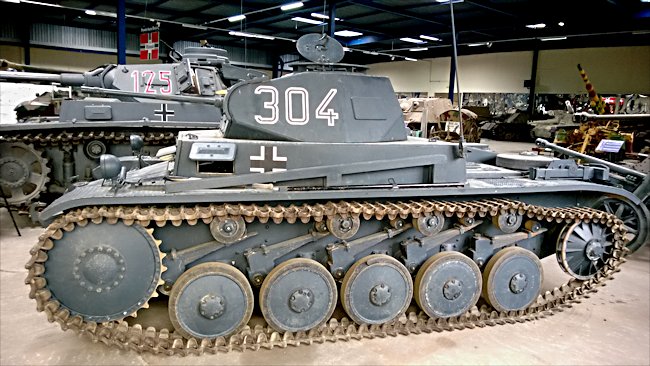
German Panzerkampfwagen II Ausf C tank
Bauer was sent to attack Tula. "It was a very big city with a major tank building industry. The city was protected by a large anti-tank ditch. Apparently this ditch was built in such a way that no tank could drive across it or through it. Overnight we received the orders that the back of eight or nine tanks should be laden with logs on their rear end. When the attacked started at dawn those tanks started to drive through the snow towards the tank ditch."
"It was a distance of about 1,200 – 1,500 metres. The panzers drove towards the tank ditch at top speed. One of the worst artillery and tank shelling attacks I had encountered followed. When the lead tanks got close they reversed towards the tank ditch. The turret crew got out and with an axe cut the ropes. The logs fell down into the tank ditch. Then the next tank did the same until a bridge of logs had filled the gap. The next group of Panzer II tanks could the drive over the logs as start the attack on Tulsa."
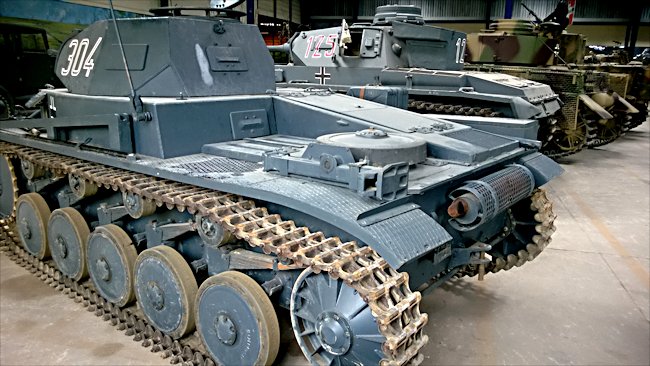
German Panzer II tank PzKpfw II Ausf C Sd.Kfz. 121
"It was a great adventure all the more because one of the tanks ended up driving into the ditch. It was covered with the remaining logs. The crew had to stay there until the evening whilst panzers drove over them. Then all of our tanks drove up hill towards the outskirts of the Tulsa. When I got to the top of the hill I took a direct hit from a KV-1 76.2mm gun. My tank caught fire immediately. I was able to jump out of the turret immediately, but my driver and radio operator burnt to death inside the tank. I had five bits of shrapnel in my thigh, one in my knee and one in my eye. I was just lying there. My comrades carried me out of this hell fire and I was evacuated back to a hospital."
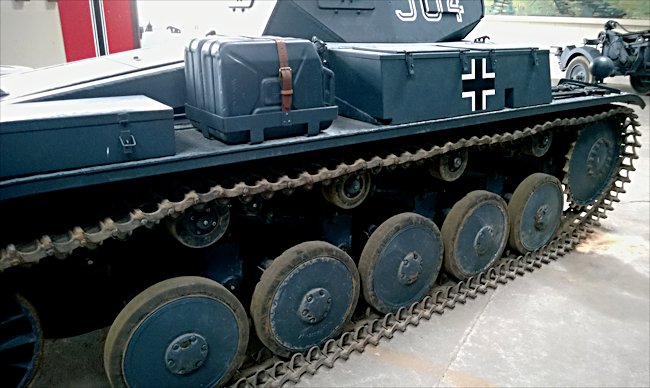
The Panzer II was first produced in 1935. Its power plant was 140 HP Maybach petrol engine. It featured a new suspension system that consisted of five large independent sprung road wheels that gave it a smoother ride than previous tanks. It weighed 10 tonnes which was heavier than the Panzer I, but it was faster and more powerful. It had a road speed 30 mph.
955 Panzer IIs would be committed in the blitzkrieg battle for France in May 1940. Almost half of the Army's total tank strength. Its 20 mm main cannon was a converted aircraft gun. It was no match for many of the Allied tanks. It was essentially a lightly armed Scout tank but was used by the German high command as if it was a main battle tank.
It suffered a lot of losses when it came up against some of the bigger French and British tanks. The only way it made up for it inadequacy was by being deployed en masse so they could surround enemy tanks like the Wolf Pack, get close using speed, and fire at the rear and side of their vehicles.
The Scrapyard Tank

The above photograph was taken in 1980 at the scrapyard in Turin. You can see the 304 tactical number painted on the side of the turret although the number 4 is obscured. The photograph below was taken later in the storage yard at the Musée des Blindés, French tank Museum. The photographs were taken by Christophe Mialon.

Where can I find other preserved Panzer II Tanks?
- Pz Kpfw II Ausf. C - Musée des Blindés, Saumur, France
- Pz Kpfw II Ausf. C - Kalemegdan Military Museum, Belgrade Serbia
- Pz Kpfw II Ausf. C - Military Historical Museum, Lenino-Snegiri, Russia
- Pz Kpfw II Ausf. C - Canadian War Museum, Ottawa, Canada
- Pz Kpfw II Ausf. C - Wreck, Andre Becker Collection, Belgium
- Pz Kpfw II Ausf. F - Bovington Tank Museum England
- Pz Kpfw II Ausf. F - Kubinka Tank Museum, Russia
- Pz Kpfw II Ausf. F - National Armor and Cavalry Museum, Fort Benning, GA, USA
- Pz Kpfw II Ausf. F - Westwall Museum, Pirmasens, Germany
- Pz Kpfw II Ausf. L "Luchs"- Bovington Tank Museum England
- Pz Kpfw II Ausf. L "Luchs"- Musée des Blindés, French Tank Museum Saumur, France
- Pz Kpfw II Ausf. L "Luchs" Replica - Private collection, America
- Source - Pierre-Oliver Buan - http://the.shadock.free.fr/Surviving_Panzers.html
WW2 Tank Books

